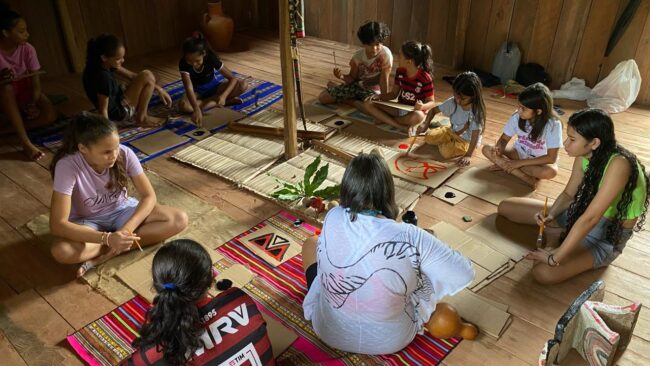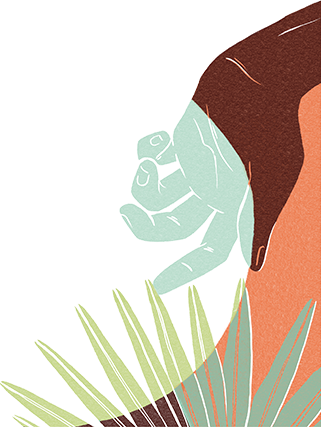 09.08.2024
09.08.2024
Unprecedented, Casa Fund support strengthens Indigenous culture and language projects
In Amambai, Mato Grosso do Sul, the municipal school Mbo’eroy is a reference point that goes beyond education. The building is attended by more than 900 Indigenous students from the Guarani Kaiowá people on weekdays, provides meals for the students, and transforms into a community gathering point on days off.
For years, Daiane Aquino Cáceres, an Indigenous school principal, has wanted to bring traditional knowledge into the classroom in the form of educational materials. Now, an important step in this direction has just been taken. Soon, students will receive books with stories that, until now, were only told by elders. The teachers have turned these oral traditions into playful written narratives, printed to aid the students’ learning.
“These are stories where they are the protagonists. The children see themselves in the reading. So the learning improves, it makes memorization easier, it encourages dialogue, and all of this is thanks to the project that we are now able to put into practice,” says Cáceres.

Students and teachers of the Guarani Kaiowá School | Photo: Guarani Kaiowá School Archive
The project Cáceres refers to was one of the selected initiatives in the “Education for Well-being – Support for Indigenous Communities for Equity in Education” call for proposals, launched in mid-2023 by the Casa Socio-Environmental Fund. In its first edition, the call mobilized 115 proposals and surprised the coordinators.
“We were surprised by the volume and quality of the projects. Many applicants reported that it was the first time they saw the possibility of receiving support for indigenous education initiatives,” commented Inimá Krenak, Program Manager at Casa Fund.
Although this recent call was the first specifically focused on indigenous education, the Casa Fund has a long history of working in this field. Since its creation in 2005, it has supported 402 indigenous organizations from 182 different peoples. This engagement caught the attention of the American philanthropic entity Imaginable Futures, the donor of the resources, Inimá explains.
The proposals were so well evaluated that the Casa Fund managed to support twice the initially planned number: instead of 15, 31 proposals were selected. Most of them came from the Amazonian states, a region that concentrates the majority of the indigenous population in the country.
At the Guarani Kaiowá school, the extra funding also helps teachers to provide what is needed to ensure learning. “We can offer improvements in the classroom, from pencils to erasers. It already makes our work easier because some of our children can’t afford to buy a pencil sharpener or a notebook,” comments Cáceres.
A story of resistance
In Rondônia, Márcia Mura has personally experienced the barriers that arise when a public school teacher attempts to bridge the gap between traditional Indigenous knowledge and formal education. Márcia faced significant resistance and was arbitrarily removed from her duties at the school where she worked, within her own community.
When the project she submitted to the Casa Fund’s call for proposals was approved, it felt like a confirmation that she was on the right path, despite the painful experience she had endured in the state public school system.
“Our goal is to align these traditional Indigenous knowledges with the curriculum components, to make Indigenous affirmation pedagogy present within the riverside context, where Indigenous families also live. It’s about promoting this connection with other territories where the Mura people also reside,” Márcia explains.
The project travels through regions with this strategy in tow to mobilize educators and leaders. It’s as if the entire community becomes a school, with the participation of elders, youth, and children. The first stage took place at Lake Uruapiara, Amazonas, where Márcia’s grandmother lived. The experiences included Indigenous literature circles and traditional-style roof thatching, the teacher explains.

In the Nazaré district (Rondônia), Mura and riverside children engage with art, aiming to stimulate the memory and sense of belonging of the Mura people and other Indigenous communities. Photo: Márcia Mura
Another stage took place along the banks of the Itaparanã River in southern Amazonas, a region marked by conflicts and the struggle for land demarcation. The work done with the Indigenous school involved elders, leaders, and children. “We use Art, History, and Architecture to teach, for example, mathematics. We follow the planting of corn, where the elders teach a traditional planting technique, and at the same time, we work on mathematical operations,” she mentions.
The project’s experiences also revive memories. Workshops using raw materials from the Amazon Rainforest, such as straw, teach how to weave toys, pinwheels, baskets, and pass on the traditional technique to the next generation—the same technique that Márcia learned from her grandmother.
Márcia spent some time in a city school after being removed from teaching in the community. During this period, despite all the resistance she encountered and the pressures she faced, the teacher helped many students reconnect with their roots. “The gatherings helped many students identify themselves, and they started to present themselves as Indigenous. They felt comfortable talking about their people, their culture, and where they came from,” says Márcia, highlighting all the prejudice and attempts at erasure that Indigenous people face in an urban context.
Unprecedented Gatherings
In the Xingu Indigenous Territory, efforts are focused on ensuring the quality of education in schools spread across the villages. That’s why the grant opportunity arrived at a crucial moment for the Xingu Indigenous Land Association (ATIX). The organization was seeking ways to fund the first educational gathering in the territory’s history. In a place like Xingu, the logistical challenges and costs are immense: moving from one village to another involves hours of navigation and hundreds of liters of gasoline.

1st Indigenous Education Gathering of the Xingu Indigenous Territory held in 2023 – Xingu Indigenous Land Association (ATIX) – Mato Grosso. Photo: Tepkarara Crispim Khĩsêtje
As the Proposal Was Approved, the Project Finally Came to Life in November 2023. It was the long-awaited opportunity for over 200 teachers to understand how different schools operate, how the school curriculum and indigenous culture intertwine in the classroom, and to exchange pedagogical practices between communities.
“Since the territory began promoting an educational movement back in the 1980s, there had never been a gathering like this. It was an extremely important opportunity and a chance to facilitate emotional reunions with the pioneers,” recounts Douglas Floresta, one of the coordinators.
Since that early beginning, some programs have emerged to support indigenous education. In 2001, for example, the Urucum Pedra Brilhante Project graduated the first class of intercultural indigenous teachers. Many who were part of this group later enrolled in the Intercultural Teaching Degree at the State University of Mato Grosso, which launched its first class that same year.
Many of the teachers who participated in these programs left the gathering in Xingu with a new idea: to encourage educational programs focused on indigenous women and to establish a Federal Institute within the territory.
“The educational movement demands that women’s presence be more valued and that female students receive more encouragement, so they can complete high school and continue to university,” says Floresta.
Of the more than 200 teachers in Xingu, only four are women—and only one of them is currently attending university. In total, the 26,000-square-kilometer territory has 17 central schools and several annexed classrooms distributed among the villages. The Xingu was demarcated in 1961 and is home to 16 peoples: Aweti, Ikpeng, Kaiabi, Kalapalo, Kamaiurá, Kĩsêdjê, Kuikuro, Matipu, Mehinako, Nahukuá, Naruvotu, Wauja, Tapayuna, Trumai, Yudja, and Yawalapiti.
Critical Online Training
The enthusiastic participation in the course “Multipliers for Strengthening Indigenous Languages in Amazonas,” designed by the Amazonian Forum for Indigenous School Education and Health (Foreeia), greatly impressed Alva Rosa Vieira. She led the submission process for the program aimed at strengthening indigenous languages across various peoples, which received support from the Fundo Casa.
With virtual theoretical training, the course was developed in the context of the International Decade of Indigenous Languages (2022-2032), proclaimed by the United Nations Educational, Scientific and Cultural Organization (UNESCO). In Brazil alone, there are 274 indigenous languages spoken by 305 peoples, according to data from the National Foundation of Indigenous Peoples (Funai).
“There are many challenges we face. We receive questions like: ‘a teacher who no longer speaks the language is not indigenous.’ The course addresses all these questions, bringing in experts to discuss how languages should be nurtured and strengthened,” says Vieira.
A Doctor of Education, Vieira is a member of the Tukano people and one of the founders of Foreeia, established in 2014. She says the support provided by Fundo Casa was essential to format an online course, which will culminate in an in-person seminar. In the past, many projects were funded voluntarily by members, often with personal sacrifices, Vieira recalls.
“The internet also facilitates the delivery of messages to the villages. We also considered offering the course on a more accessible platform. Often, two or three people are sharing a cell phone screen to participate in the class. The interest is truly remarkable,” says the initiative’s coordinator, which has 200 enrolled and 180 active participants.
The training is not limited to teachers. The goal is to guide students and indigenous leaders in efforts to value indigenous languages, both inside and outside the classroom, discuss proposals to improve education and health, and strengthen the fight for rights.
Next Steps
The first call for indigenous education projects by Casa Fund opened a door and revealed a demand for support in this area. That’s why the expectation is for the initiative to continue, says Inimá Krenak.
“The projects are being finalized, and we hope to open new calls for proposals, seeking partners who can provide support. It has become clear that this topic needs backing and resources,” says the project manager at Casa Fund.
By Nádia Pontes for Casa Socio-Environmental Fund
